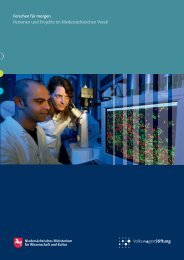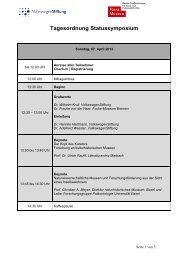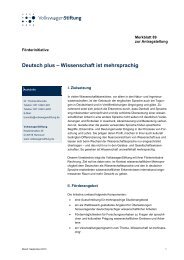Funding
Funding
Funding
Create successful ePaper yourself
Turn your PDF publications into a flip-book with our unique Google optimized e-Paper software.
32<br />
To begin with, small amounts of dye molecules<br />
are placed in powder form onto a<br />
vaporizer (top photo). The molecules are then<br />
evaporated onto an insulator surface and<br />
later stimulated by a scanning tunneling<br />
microscope (STM). Liquid nitrogen and liquid<br />
helium are used to keep the STM at extreme<br />
low temperature. Our photo shows Professor<br />
Dr. Jascha Repp filling the nitrogen tank.<br />
from the sides of this quadrant to the top and bottom, or vice versa, the<br />
geometry of the molecule remaining constant.<br />
“This molecule acts as a switch since the electrical current changes upon flipping<br />
of hydrogen atoms”, he elucidates. However, just one switch of this type<br />
is clearly not enough for electronic applications. If, though, we can succeed in<br />
linking several up into larger switching arrays it will be possible to transport<br />
information via the molecules. And this is what he and his colleagues from<br />
the IBM research laboratory in Zürich actually did achieve when they succeeded<br />
in joining up three such molecules – “just a small step towards building<br />
more complex switches with single molecules”, Jascha Repp points out.<br />
However, an accomplishment that led to a publication in the renowned journal<br />
“Science” (31 August 2007, Vol. 317. no 5842, pp.1203-1206).<br />
Of course, it is not possible to build this type of switch on the lab bench. The<br />
laboratory he and his colleagues work in resembles something between a<br />
science-fiction film set and a submarine. Vast surfaces of polished stainless<br />
steel meet the eye in the basement rooms of the Institute for Experimental<br />
and Applied Physics in Regensburg. Heavy bolts and flanges hold the small<br />
steel chamber together, there are just narrow windows through which the<br />
researchers can look into the inside. “All our experiments have to be carried<br />
out inside this chamber”, Jascha Repp explains, “and we cannot enter it ourselves,<br />
or even use our hands”. Using small metal grips controlled from the<br />
outside, he evaporates the dye molecules onto the insulator, where then in<br />
the center of the cold steel chamber they are stimulated and activated by<br />
means of a fine needle. At its center, the chamber houses a scanning tunneling<br />
microscope. Through this instrument, no bigger than a man’s fist, the<br />
Regensburg scientist can view the individual atoms which make up his molecules.<br />
The space in which Jascha Repp moves things around with his grips is<br />
completely empty: Quite literally so – for he is working in an ultrahigh vacuum.<br />
Moreover, it is extremely cold. His very special switches will only function at<br />
nearly absolute zero, i.e. around minus 270 degrees Celsius. The needle of the<br />
scanning tunneling microscope moves infinitely slowly over the research<br />
specimen, scanning the surface atom by atom.<br />
This sort of work calls for immense patience. Jascha Repp, though, is a patient<br />
person. Full of patience. Working with the grips in an ultrahigh vacuum<br />
chamber is not really so bad, he says; it takes him about half a day to prepare<br />
a specimen. And even when his equipment – which he built himself by the<br />
way – sometimes suffers a breakdown, he remains perfectly calm. He may<br />
well do so, for half a week will have to pass by before he is even able to examine<br />
a defective soldering joint, for instance. For it takes much more then just a<br />
few minutes to fill the vacuum in the chamber with air and warm it up to<br />
room temperature. “A much bigger problem than that, though, is that we<br />
then have to put the whole steel chamber inside a huge sort of heated oven<br />
to get rid of the condensed water on the chamber walls.” There is pleasure
















